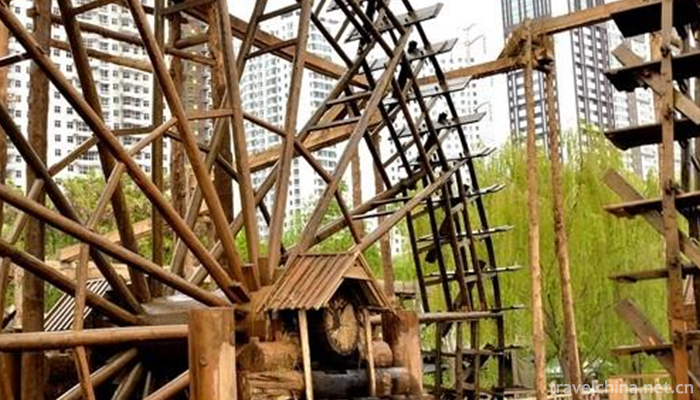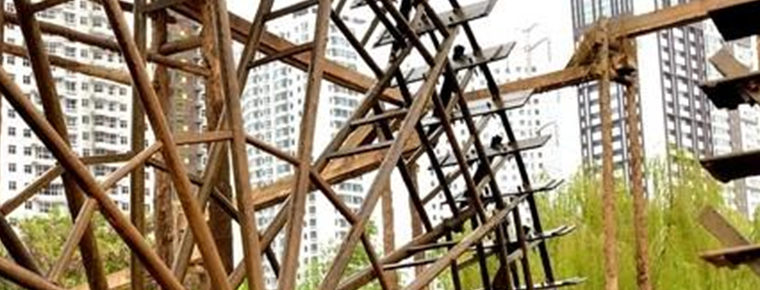Making Techniques of Lanzhou Yellow River Waterwheel
Making Techniques of Lanzhou Yellow River Waterwheel
Lanzhou Yellow River waterwheel production technology, Lanzhou City, Gansu Province, local traditional handicraft, one of the national intangible cultural heritage.
Lanzhou Yellow River waterwheel production technology uses Pinus tabulaeformis in Daxing'an Mountains and willow and elm in the north as raw materials, after drilling, pulling mortise, tenon wedge, dock, piggyback beam and axle processing, and finally on-site installation is completed.
On May 20, 2006, the craftsmanship of Lanzhou Yellow River waterwheel was approved by the State Council and listed in the first batch of national intangible cultural heritage list, project number: _-48.
historical origin
The Yellow River Waterwheel originated in the Ming Dynasty. According to the Record of Rebuilding Gaolan County, it was created by Duanjiatan Renduan in Lanzhou in the Ming Dynasty. "When Xuliju lived, he turned over the car and pulled the river upside down to irrigate the fields, which gave rise to ingenious thinking. Farmers in Chuanhe follow suit. Duan continued his career in his early years after several ups and downs, returned to his hometown in his later years, and devoted himself to the imitation of waterwheel. After many repetitions, Duan finally succeeded in Jiajing's thirty-five years (1556).
In 1556, Duan continued to learn from the irrigation technology of drum cars in Tonghe, Yunnan Province, and created a waterwheel suitable for local use in Lanzhou. Beginning to erect on the North Bank of the Yellow River outside Guangwumen. Later, three rounds were erected at the north entrance of Zhenyuan Road to irrigate more than 600 mu vegetable border orchards nearby. This is the place name "Waterwheel Park". Since the end of Ming Dynasty, water carts have been widely used in Gaolan, Baiyin, Jingchuan, Pingliang, Yinchuan and Shaanxi in the Yellow River Basin, which has promoted the development of agricultural production in these areas.
In 1952, Lanzhou waterwheel reached its heyday. There were 252 waterwheels on both sides of the Yellow River. The total irrigation area increased from more than 20,000 Mu before the founding of New China to 100,000 mu. Especially from Guangwumen to Yantan River, it is also the gathering place of waterwheel. Single-wheel, double-wheel, three-wheel, five-wheel and other forms are different and magnificent. Therefore, here is also known as "Waterwheel Park", Lanzhou is also known as "Waterwheel City".
Process characteristics
Lanzhou Dashui Truck seems to have simple structure and no traditional drawings, but it has exquisite conception, complex structure, ingenious conception, exquisite material selection, local materials, exquisite production technology, the use of Pinus tabulaeformis in the Great Hinggan Mountains and willows and elms in the north, showing the superb wisdom and excellent skills of traditional craftsmen.
1. Advanced technology, low cost, labor saving and labor convenience have changed the situation of the two sides of the Yellow River feeding on the sky, so it has the characteristics of dependence.
2. Because of the vast land and extensive use in the Yellow River Basin, it has extensive characteristics.
Thirdly, Duan Xun changed to use elm, Sophora and willow to make waterwheel according to local conditions, so it has the characteristics of simplicity.
4. Since the creation of the waterwheel, it has been standing on the Bank of the Yellow River. With the flow and inertia of the water in the Yellow River, it drives the rotation of the waterwheel, so it has the ornamental characteristics.
Inheritance and protection
Inheritance value
Lanzhou Waterwheel is an important part of the culture of the Yellow River Basin. It contributes a lot to the people of Lanzhou and the lower reaches, and plays an immeasurable role in the development of Lanzhou society. As an important part of the Yellow River culture, it also embodies the creativity of the Chinese nation and provides evidence for the study of Chinese agricultural civilization and water history.
Inheritance status
In 1952, there were still 252 water trucks along the Yellow River in Lanzhou. Since the electric irrigation technology has been widely used, the number of water trucks has been decreasing year by year, and the producers have few successors. Facing the endangered situation, it has become an urgent and important task to protect the production technology of the Yellow River water truck.
Inheriting characters
Duan Yicun, male, on May 16, 2018, Duan Yicun was selected as the representative successor of the fifth batch of national intangible cultural heritage projects, which was declared by Lanzhou City, Gansu Province. Project Name: Lanzhou Yellow River Waterwheel Manufacturing Techniques.
protective measures
On August 26, 2005, Lanzhou built a waterwheel exposition park, which reproduced the spectacular scene of waterwheel stands on both sides of the Yellow River more than 50 years ago.
In 2007, in order to protect this precious traditional cultural heritage, "Lanzhou Yellow River Waterwheel Production Techniques" was included in "Lanzhou Historical and Cultural Heritage Protection Plan", which was protected by legislation.
social influence
Important exhibition
In 2006, 2007 and 2008, Lanzhou Yellow River Waterwheel was invited to attend the China (Shenzhen) International Cultural Industry Fair (hereinafter referred to as the "Cultural Fair") held at the Shenzhen Convention and Exhibition Center, and won high praise.


-
1.Shanghe Garden Scenic Spot in Qingming Dynasty
Qingming Shanghe Garden is a large-scale theme park of Song Dynasty cultural scenery constructed by the people's government of Kaifeng City in Henan Province
Time 2019-02-07 -
2.Xujiahuiyuan Scenic Area
Xujiahuiyuan Scenic Spot is located in Xujiahui, Shanghai Metropolitan Tourism Center Circle. It starts from Wanping South Road, Tianping Road and Huashan Road in the east
Time 2019-02-26 -
3.Zamuni of Tibetan Nationality Playing and Singing
"Zamuni" is also called the Six Stringed Orchestra, a traditional Tibetan plucked instrument. Mainly spread in Lhasa, Shannan, Ali, Lazi (Bahir), Sakya, Angren, Dingri and other places
Time 2019-04-15 -
4.Hu Qingyutangs Traditional Chinese Medicine Culture
Hu Qingyutang's traditional Chinese medicine culture is one of the national intangible cultural heritages and the traditional trade customs preserved by Hu Qingyutang.
Time 2019-05-03 -
5.Wuju Opera
Wu Opera, commonly known as Jinhua Opera, is one of the local operas in Zhejiang Province. It centers on Jinhua area and is popular in Jinhua, Lishui, Linhai, Jiande, Chun'an, Yushan, Shangrao, Guixi,
Time 2019-06-30 -
6.Xinhui Sunflower Art
Xinhui Sunflower Art, a traditional Chinese handicraft, originated in Xinhui District, Jiangmen City, Guangdong Province. Xinhui Sunflower Art has a history of more than 1600 years, and became famous
Time 2019-07-06 -
7.Yao an Bazi Cavity
On June 7, 2008, Yao'an Baziqiang, declared by Yao'an County, Yunnan Province, was listed in the second batch of national intangible cultural heritage list with the approval of the State Council. Heri
Time 2019-07-11 -
8.Legend of Yongding River
Yongding River legend is one of the local folklores in Beijing. Among many legends, the legend of river blocking is representative; the legend of Shijing Mountain and Shijing Mountain; the legend of b
Time 2019-07-14 -
9.The world is so big still meet you Cheng Xiang Tik Tok Songs 2020 Hot Songs
"The world is so big still meet you " is composed by htet Aung Lwin and sung by Cheng Xiang. It is the Chinese version of myanmar music "for Ma". It was officially released on Janu
Time 2020-05-21 -
10.Longtouguan
Longtouguan, a cultural relic protection unit in Sichuan Province. Located in Jiangyang West Road, Jiangyang District, Luzhou City, Sichuan Province. Originally an ancient pass, it was built in the Shu Han Dynasty to build a wall for the earth; it was rebuilt in the 11th year of Chongzhen in the Ming Dynasty and rebuilt in the second year of Tongzhi in the Qing Dynasty.
Time 2020-10-16 -
11.Meishan Sports
In 2019, 45 games will be held and 30000 people will participate in the games. At the end of the year, there were 116 sports associations. By the end of the year, there were 1410 sports venues in the education system. Meishan post and telecommunication
Time 2020-12-18 -
12.Dazhou folk culture
Dazhou yuanjiu Climbing Festival this tradition has been followed for thousands of years, every year on the ninth day of the first month, hundreds of thousands of people travel to the city, this spectacular scene is also rare in the country. It is said that i
Time 2020-12-20